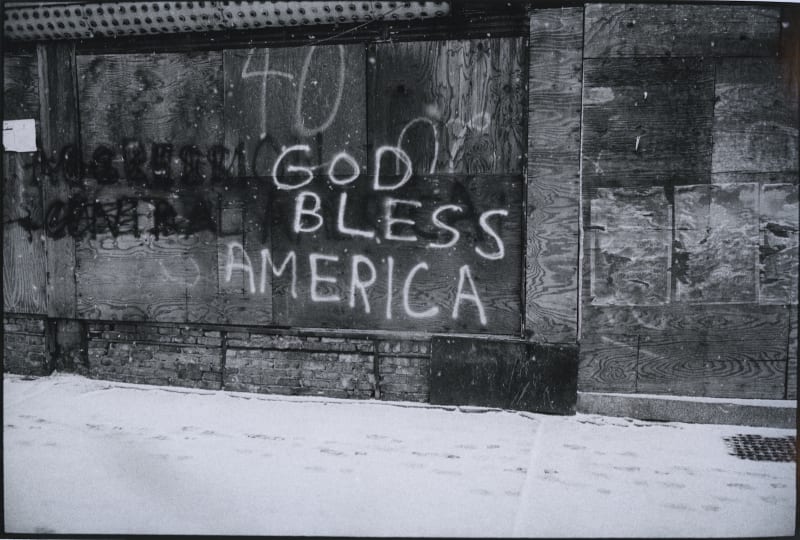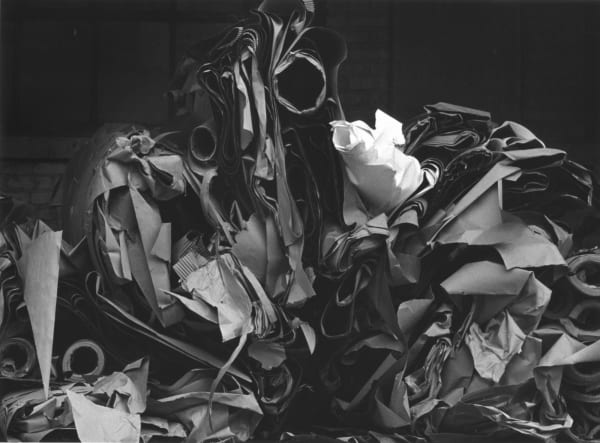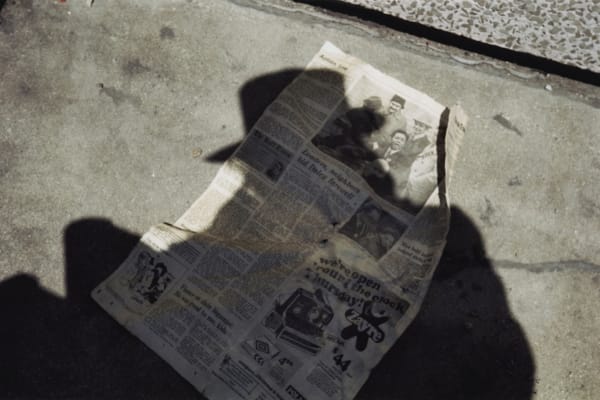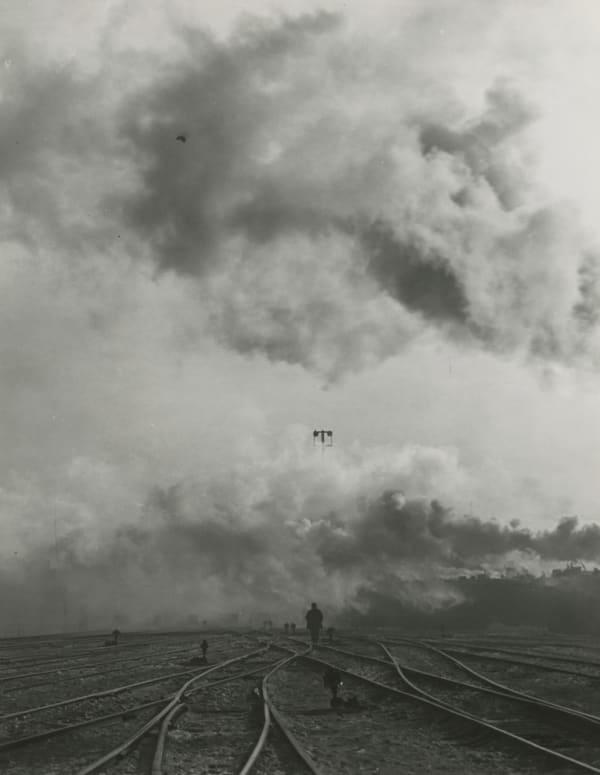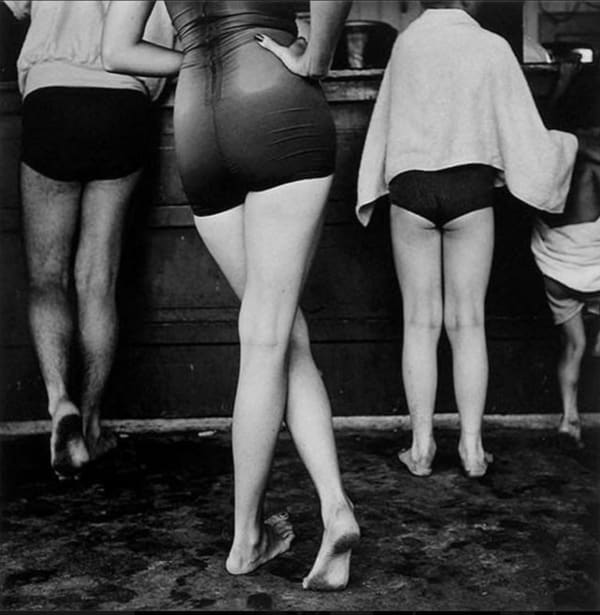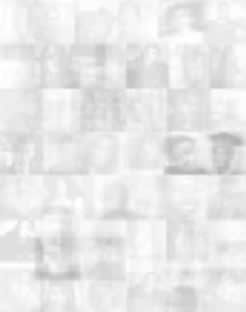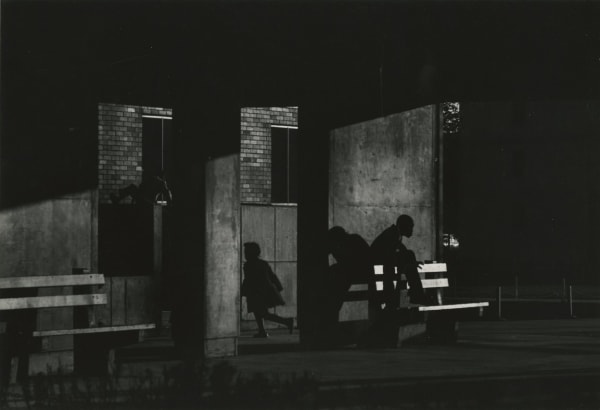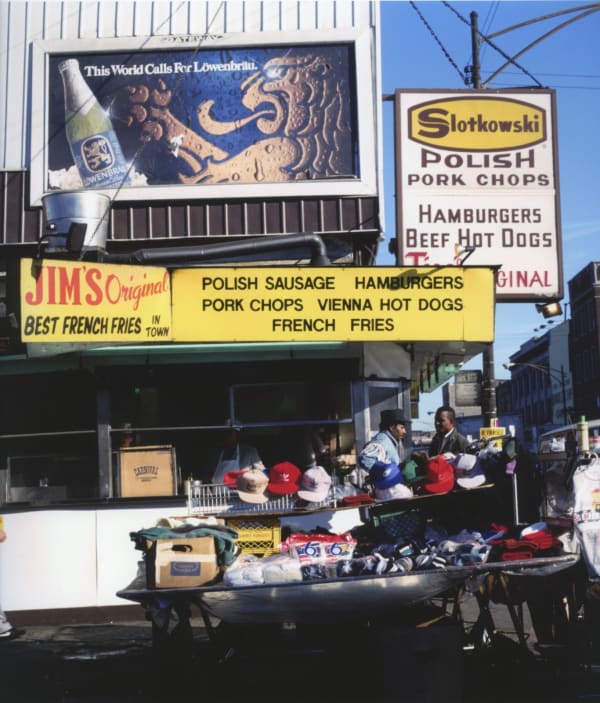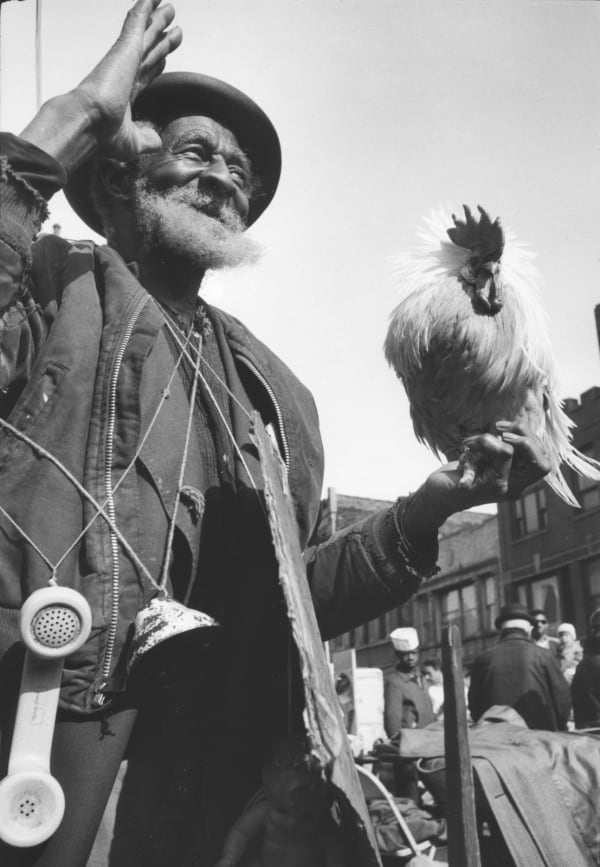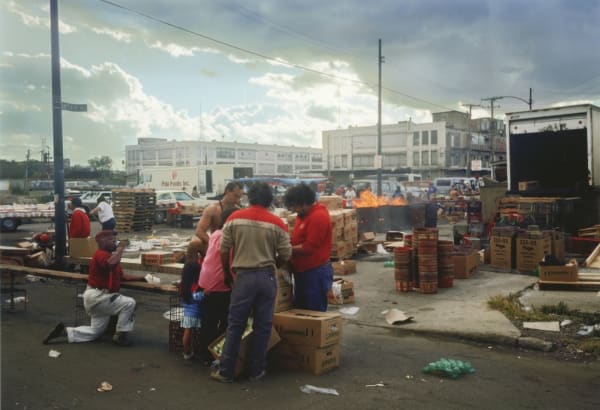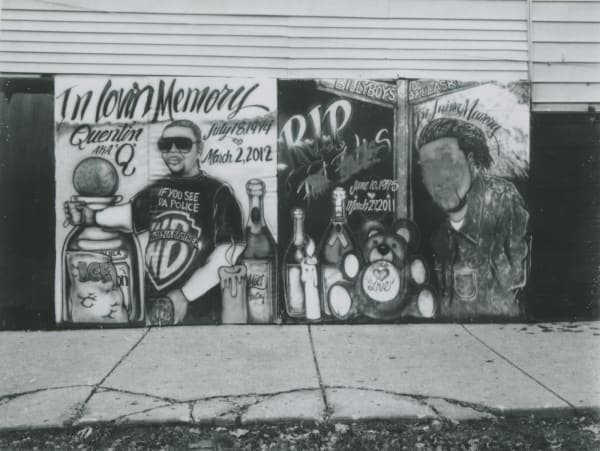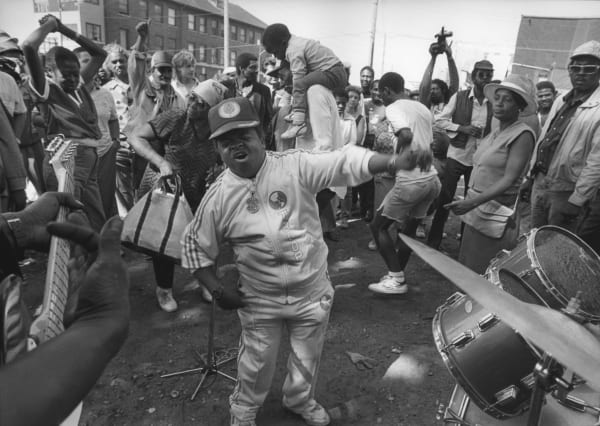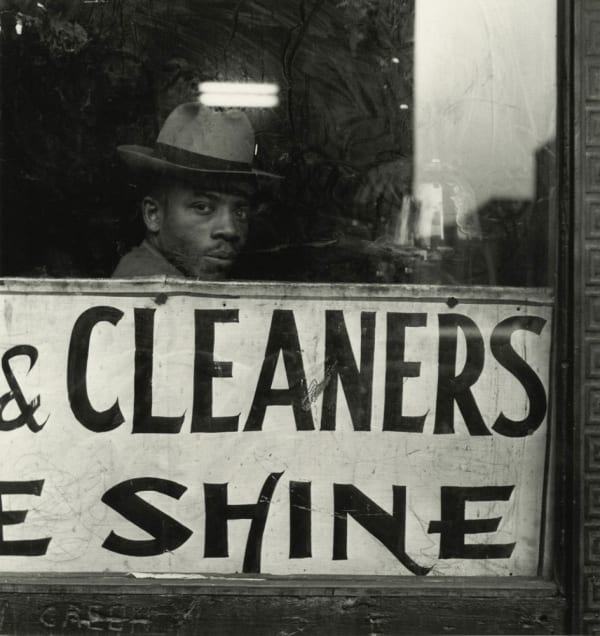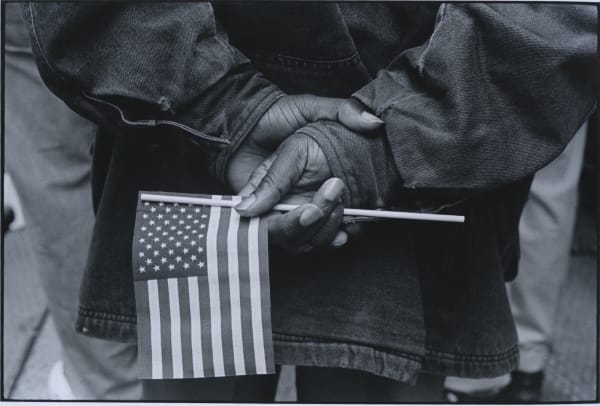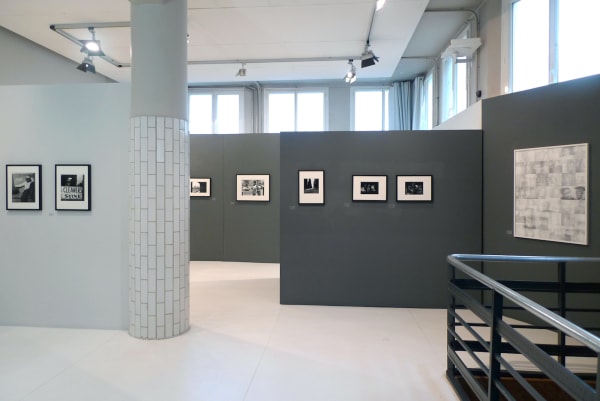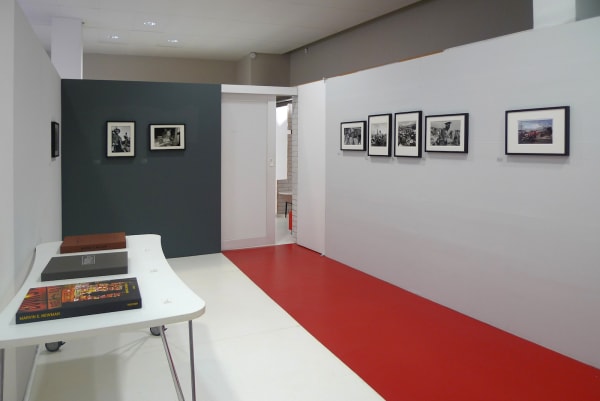Black Chicago: Group show
The seven photographers who are the subject of this exhibit – Wayne Miller, Ray K. Metzker, Yasuhiro Ishimoto, Marvin E. Newman, Vivian Maier, Tom Arndt and Carlos Javier Ortiz – cover the period from 1940 to the present. None of them has followed the same path and none have the same way of looking at things. Each one presents us with a different image of the African-American community that had come to Chicago from the Deep South with the hope of greater freedom and better jobs. Their photos are a shocking and highly artistic testament to the life of the blacks of Chicago for over a half century.
-
 Tom Arndt"God Bless America", painted on a building owned by Al Capone, ChicagoTirage gélatino-argentique moderne, réalisé par l'artiste17,9 x 26,5 cm
Tom Arndt"God Bless America", painted on a building owned by Al Capone, ChicagoTirage gélatino-argentique moderne, réalisé par l'artiste17,9 x 26,5 cm
Dim. papier: 27,5 x 35,3 cm -
 Ray K. Metzker, Chicago - Loop, 1958
Ray K. Metzker, Chicago - Loop, 1958 -
 Marvin E. NewmanBoy Blowing Bubble Gum, ChicagoTirage gélatino-argentique postérieur24 x 19 cm
Marvin E. NewmanBoy Blowing Bubble Gum, ChicagoTirage gélatino-argentique postérieur24 x 19 cm
Dim. papier: 25,5 x 20,3 cm -
 Ray K. MetzkerChicago - Non LoopTirage gélatino argentique postérieur, réalisé par l'artiste15,3 x 21 cm
Ray K. MetzkerChicago - Non LoopTirage gélatino argentique postérieur, réalisé par l'artiste15,3 x 21 cm
Dim. papier: 20 x 25 cm
-
 Vivian MaierSelf-portrait, Chicago area, MayTirage chromogène, posthume25 x 38 cm
Vivian MaierSelf-portrait, Chicago area, MayTirage chromogène, posthume25 x 38 cm
Dim. papier: 40 x 50 cm -
 Vivian MaierChicago, ILTirage chromogène, posthume30 x 30 cm
Vivian MaierChicago, ILTirage chromogène, posthume30 x 30 cm
Dim. papier: 40 x 50 cm -
 Marvin E. NewmanRailroad Yards, Southside, ChicagoTirage gélatino-argentique d'époqueDim. papier: 24 x 19 cm
Marvin E. NewmanRailroad Yards, Southside, ChicagoTirage gélatino-argentique d'époqueDim. papier: 24 x 19 cm -
 Wayne F. MillerChicago's SouthsideTirage gélatino-argentique postérieur25,4 x 30,48 cm
Wayne F. MillerChicago's SouthsideTirage gélatino-argentique postérieur25,4 x 30,48 cm
Dim. papier: 27,5 x 35,4 cm
-
 Yasuhiro IshimotoNorth Avenue Beach, ChicagoTirage gélatino-argentique postérieur réalisé par l'artiste24 x 24 cm
Yasuhiro IshimotoNorth Avenue Beach, ChicagoTirage gélatino-argentique postérieur réalisé par l'artiste24 x 24 cm
Dim. papier: 27,7 x 37,7 cm -
 Marvin E. Newman, Two Girls at Lake Michigan, Chicago, 1952
Marvin E. Newman, Two Girls at Lake Michigan, Chicago, 1952 -
 Marvin E. NewmanWooden Houses, Southside, ChicagoTirage gélatino-argentique d'époqueDim. papier: 19 x 24,2 cm
Marvin E. NewmanWooden Houses, Southside, ChicagoTirage gélatino-argentique d'époqueDim. papier: 19 x 24,2 cm -
 Carlos Javier Ortiz, D-MAN, Englewood, Chicago, 2007
Carlos Javier Ortiz, D-MAN, Englewood, Chicago, 2007
-
 Carlos Javier Ortiz, Bronzeville, Chicago, 2009
Carlos Javier Ortiz, Bronzeville, Chicago, 2009 -
 Carlos Javier OrtizThe LostTirage Jet d'encre93 x 74 cm
Carlos Javier OrtizThe LostTirage Jet d'encre93 x 74 cm
Dim. papier: 98 x 79 cm -
 Marvin E. NewmanChildren Sitting in Front of Restaurant Window, ChicagoTirage gélatino-argentique postérieur19 x 24 cm
Marvin E. NewmanChildren Sitting in Front of Restaurant Window, ChicagoTirage gélatino-argentique postérieur19 x 24 cm
Dim. papier: 20,3 x 25,5 cm -
 Marvin E. NewmanRat and Street Sign Reflection, ChicagoTirage gélatino-argentique postérieur24 x 19,4 cm
Marvin E. NewmanRat and Street Sign Reflection, ChicagoTirage gélatino-argentique postérieur24 x 19,4 cm
Dim. papier: 25,5 x 20,3 cm
-
 Marvin E. NewmanChicagoTirage gélatino-argentique d'époqueDim. papier: 16,8 x 22 cm
Marvin E. NewmanChicagoTirage gélatino-argentique d'époqueDim. papier: 16,8 x 22 cm -
 Marvin E. NewmanGarbage, Southside, ChicagoTirage gélatino-argentique d'époqueDim. papier: 19,4 x 24,5 cm
Marvin E. NewmanGarbage, Southside, ChicagoTirage gélatino-argentique d'époqueDim. papier: 19,4 x 24,5 cm -
 Vivian MaierChicagoTirage chromogène, posthume30 x 30 cm
Vivian MaierChicagoTirage chromogène, posthume30 x 30 cm
Dim. papier: 40 x 50 cm -
 Marvin E. NewmanNewly-arrived Family, ChicagoTirage gélatino-argentique d'époqueDim. papier: 25 x 34 cm
Marvin E. NewmanNewly-arrived Family, ChicagoTirage gélatino-argentique d'époqueDim. papier: 25 x 34 cm
-
 Marvin E. Newman, Girls Playing Jump Rope, Chicago, 1950
Marvin E. Newman, Girls Playing Jump Rope, Chicago, 1950 -
 Ray K. Metzker, Chicago - Non Loop, 1958
Ray K. Metzker, Chicago - Non Loop, 1958 -
 Marvin E. NewmanChicagoTirage gélatino-argentique postérieur19,4 x 24 cm
Marvin E. NewmanChicagoTirage gélatino-argentique postérieur19,4 x 24 cm
Dim. papier: 20,3 x 25,5 cm -
 Patty CarrollHats, Big Jim's, Maxwell StreetTirage gélatino argentique postérieur25,3 x 25,3 cm
Patty CarrollHats, Big Jim's, Maxwell StreetTirage gélatino argentique postérieur25,3 x 25,3 cm
Dim. papier: 35,4 x 27,8 cm
-
 Ron Gordon, Wheels and hubcaps, old Maxwell Street market, 1991
Ron Gordon, Wheels and hubcaps, old Maxwell Street market, 1991 -
 James IskaEloteraTirage gélatino argentique postérieur22,8 x 22,9 cm
James IskaEloteraTirage gélatino argentique postérieur22,8 x 22,9 cm
Dim. papier: 35,4 x 27,8 cm -
 Kenneth Josephson, Chicken Charlie, 1963
Kenneth Josephson, Chicken Charlie, 1963 -
 Nathan Lerner, Untitled, 1936
Nathan Lerner, Untitled, 1936
-
 Tom PalazzoloMaxwell Street after partyTirage gélatino argentique postérieur20,5 x 30,3 cm
Tom PalazzoloMaxwell Street after partyTirage gélatino argentique postérieur20,5 x 30,3 cm
Dim. papier: 27,8 x 35,4 cm -
 Bob ThallRoosevelt Road, east of Maxwell StreetTirage gélatino argentique postérieur24,1 x 30,4 cm
Bob ThallRoosevelt Road, east of Maxwell StreetTirage gélatino argentique postérieur24,1 x 30,4 cm
Dim. papier: 27,8 x 35,4 cm -
 Jay WolkeLast sales on a SundayTirage gélatino argentique postérieur16,1 x 23,4 cm
Jay WolkeLast sales on a SundayTirage gélatino argentique postérieur16,1 x 23,4 cm
Dim. papier: 27,8 x 35,4 cm -
 Carlos Javier OrtizUntitledPolaroid9,5 x 7,3 cm
Carlos Javier OrtizUntitledPolaroid9,5 x 7,3 cm
Dim. papier: 11 x 8,5 cm
-
 Carlos Javier OrtizUntitledPolaroid9,5 x 7,3 cm
Carlos Javier OrtizUntitledPolaroid9,5 x 7,3 cm
Dim. papier: 11 x 8,5 cm -
 Carlos Javier OrtizUntitledPolaroid9,5 x 7,3 cm
Carlos Javier OrtizUntitledPolaroid9,5 x 7,3 cm
Dim. papier: 11 x 8,5 cm -
 Carlos Javier OrtizUntitledPolaroid9,5 x 7,3 cm
Carlos Javier OrtizUntitledPolaroid9,5 x 7,3 cm
Dim. papier: 11 x 8,5 cm -
 Raeburn FlerlageBasement tryouts, SouthsideTirage gélatino-argentique postérieur20,5 x 29 cm
Raeburn FlerlageBasement tryouts, SouthsideTirage gélatino-argentique postérieur20,5 x 29 cm
-
 Marvin E. NewmanChildren Fighting in Street, ChicagoTirage gélatino-argentique d'époqueDim. papier: 24 x 19,4 cm
Marvin E. NewmanChildren Fighting in Street, ChicagoTirage gélatino-argentique d'époqueDim. papier: 24 x 19,4 cm -
 Carlos Javier Ortiz, Untitled, 2012
Carlos Javier Ortiz, Untitled, 2012 -
 Carlos Javier OrtizUntitledPolaroid9,5 x 7,3 cm
Carlos Javier OrtizUntitledPolaroid9,5 x 7,3 cm
Dim. papier: 11 x 8,5 cm -
 Marc PokempnerKid DynamiteTirage gélatino argentique postérieur21,4 x 30,4 cm
Marc PokempnerKid DynamiteTirage gélatino argentique postérieur21,4 x 30,4 cm
Dim. papier: 27,8 x 35,4 cm
-
 Jack Jaffe, Halloween, Maxwell Street, 1965
Jack Jaffe, Halloween, Maxwell Street, 1965 -
 Tom ArndtMaxwell StreetTirage gélatino-argentique postérieur, issu du portfolio Maxwell Street20,4 x 30,3 cm
Tom ArndtMaxwell StreetTirage gélatino-argentique postérieur, issu du portfolio Maxwell Street20,4 x 30,3 cm
Dim. papier: 27,8 x 35,4 cm -
 Marvin E. NewmanLittle Girl, ChicagoTirage gélatino-argentique d'époqueDim. papier: 19 x 24,2 cm
Marvin E. NewmanLittle Girl, ChicagoTirage gélatino-argentique d'époqueDim. papier: 19 x 24,2 cm -
 Carlos Javier Ortiz, Night Vigil, Englewood, Chicago, 2008
Carlos Javier Ortiz, Night Vigil, Englewood, Chicago, 2008
-
 Tom ArndtWoman on the train, Southside ChicagoTirage gélatino-argentique moderne, réalisé par l'artiste21,2 x 31,3 cm
Tom ArndtWoman on the train, Southside ChicagoTirage gélatino-argentique moderne, réalisé par l'artiste21,2 x 31,3 cm
Dim. papier: 27,9 x 35,3 cm -
 Wayne F. MillerChicago's SouthsideTirage gélatino-argentique postérieur25,4 x 27 cm
Wayne F. MillerChicago's SouthsideTirage gélatino-argentique postérieur25,4 x 27 cm
Dim. papier: 27,5 x 35,4 cm -
 Tom ArndtScene at train platform, ChicagoTirage gélatino-argentique moderne20,3 x 30,3 cm
Tom ArndtScene at train platform, ChicagoTirage gélatino-argentique moderne20,3 x 30,3 cm
Dim. papier: 27,9 x 35,3 cm -
 Tom ArndtHands with flag, ChicagoTirage gélatino-argentique moderne réalisé par l'artiste17,7 x 26,2 cm
Tom ArndtHands with flag, ChicagoTirage gélatino-argentique moderne réalisé par l'artiste17,7 x 26,2 cm
Dim. papier: 27,5 x 35,3 cm
-
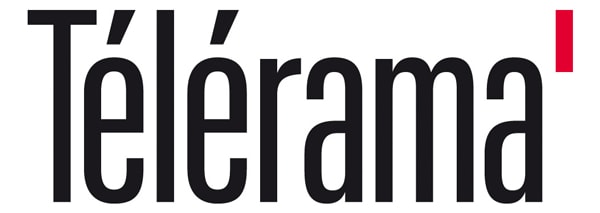
Black Chicago
Frédérique Chapuis, Télérama Sortir, 30 November 2017 -

Le gamin au centre
Frédérique Chapuis, Télérama Sortir, 29 November 2017 This link opens in a new tab. -

Black Chicago, des années 40 à nos jours
Raphaèle Santa Maria, Cultur'Easy, 20 November 2017 -

Expo Paris : 12 expositions à ne pas rater cet hiver 2017/2018
Elise Chevillard, Allovoyages, 14 November 2017
Wayne Miller, Ray K. Metzker and Marvin E. Newman are all descendants of the unique talents of Laszlo Moholy Nagy. They all began their apprenticeship at the New Bauhaus, which was transplanted to Chicago in 1937 under his aegis, and followed it through the 1950s, under the direction of Harry Callahan. Through experimental and practical learning, they trained their eye to different aspects of creation: they were introduced to industrial design and advertising, followed by a specialisation in photography and its technical aspects, especially developing finesse in capturing light, geometric forms, the movement of silhouettes and tonal contrasts. But their common background is not a mark of uniformity – quite the contrary!
Ray K. Metzker chose the most geometric approach, ingeniously following Callahan’s teaching. He explores haziness, geometric forms, all the nuances of black and white, turning streets into theatre backdrops.
Coming from New York, where he gained a wide experience in short films and photography, Marvin E. Newman brought his Japanese accomplice, Yasuhiro Ishimoto, along with him on his unencumbered walks among the African-Americans of Chicago. They were the first to capture the neighbourhood where all of Chicago’s ethnic groups mixed, and where blacks came to buy modest or eccentric second-hand clothes, play blues and offer their supernatural remedies to the ill. Maxwell Street is the court of miracles that none of the other photographers was able to resist. Newman was also a regular visitor to the South Side, where from 1940 onward black poverty has only increased. He captures the delight of children. He shows us the gaze of men, looking at things we can’t see or running from things we can only imagine.
For his part, Wayne Miller never forgot either his experience during the war in the Pacific or the vision of Hiroshima. He built a careful archive of the daily life of the blacks he lived beside in his native city from 1946 to 1948. His work is like a long tracking shot through the South Side, a territory where the exuberant, public life of some alternates with the poverty of others, hidden in the dark, muddy allies.
Vivian Maier, whose singular destiny is now common knowledge, obviously needed no instruction. It was not easy for her to venture to the black South Side. But it was a resounding success! She was able to capture the slow waiting of blacks in the street; her gaze is recognizable in every photograph.
From rural Minnesota, Tom Arndt also immersed himself in black neighbourhoods. The force of his determination is particularly evident in a photo of a man looking at us as he stands in front of the simple word save. Save. One letter short of slave...
Carlos Ortiz worked in the heart of the South Side in the 2000s, when violence was as prevalent as in the past. The young victims of their own ‘brothers’ continue a culture of solidarity in suffering. Ortiz was at work day and night, offering us the devastated landscape of Englewood where every block represents a step in the incessant movement of construction and demolition, alternately resembling a battlefield and a land of solidarity.
What do these photographers feel for the people of colour who are still on the margins of other communities? They did not hide their cameras; they went out to find them in order to capture their place in the city, their attitudes and their stories.
This exhibit is part of the events of Black Chicago, which include a public conference organised by the Paris branch of the University of Chicago from 15 to 18 November 2017.
Henri Peretz
Sociologist, Université de Paris 8, Senior Fellow Yale Univertisty
